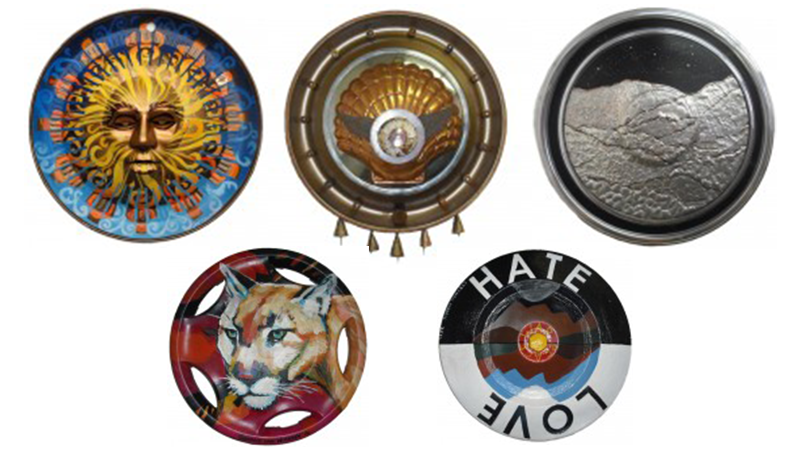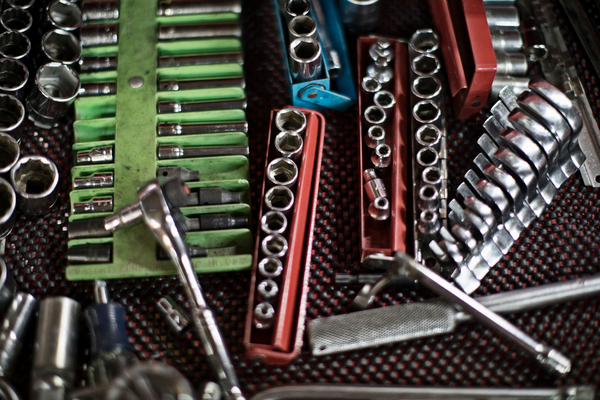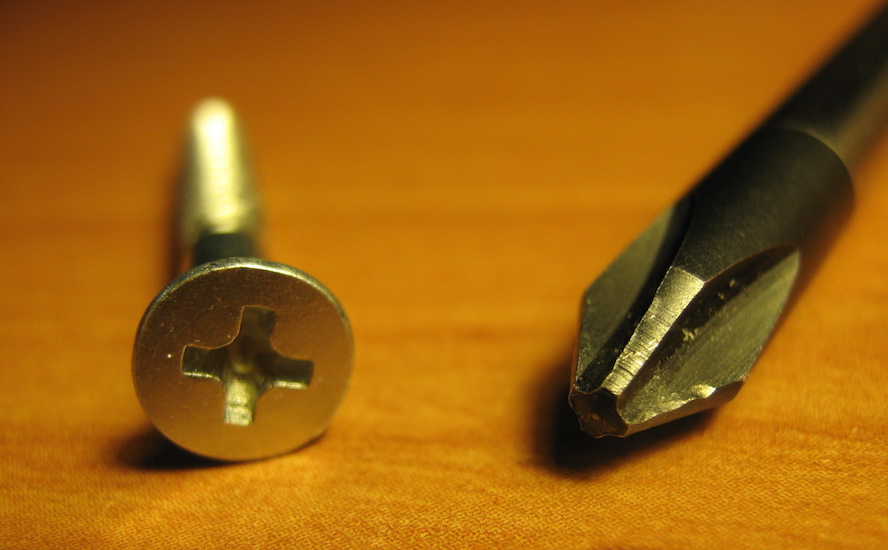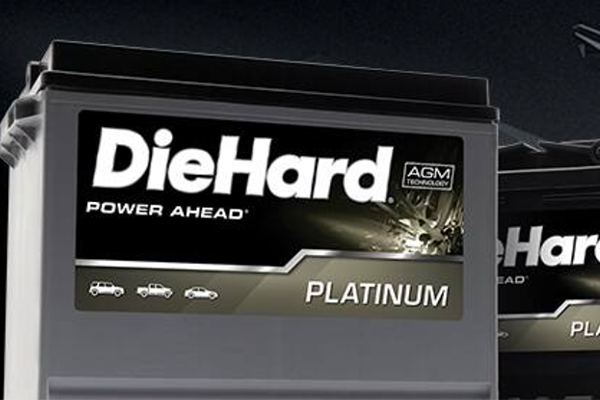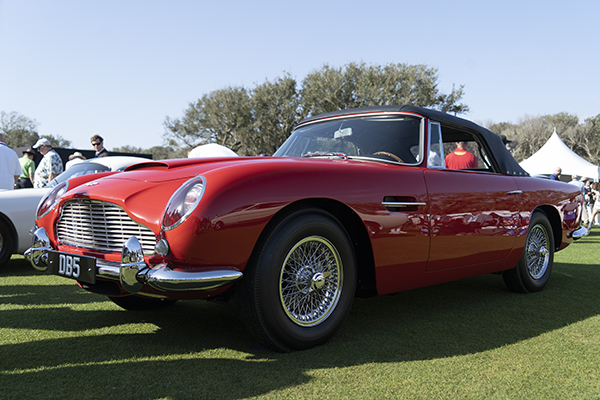Some people collect coins, others collect stamps. Still others collect spoons or rocks or napkins or doorknobs — or a multitude of other quirky objects. Advance Auto Parts, though, went in search of people who have collections that are related to cars that are both offbeat and interesting. We decided to focus on three of the most intriguing, each quite different and unique:
- The first is an international repurposing project that is turning 1,041 rusty old hubcaps into incredible museum-quality pieces of art.
- The second reveals a lifelong love of a highly underrated car part: the spark plug.
- The third one — well, if you’re super squeamish, proceed with caution.
Metal Canvases: Recycling Hubcaps into Fine Art
“I have found that the fine artists I have worked with on this project do not even flinch when looking at this white round disc of metal canvas. And why should they. Artists from the beginning of time have used cave walls (Lascaux, France and Altamira, Spain), walls of pyramids (Egyptians), animal skins (American Indians), etc… as their canvas.” —Ken Marquis, LandfillArt Founder
Ken Marquis, the genius behind the idea of hubcap art, says that he had a “Eureka! moment” five years ago while attending a car show in Pennsylvania. He had picked up a rusty old hubcap and suddenly imagined it serving as a canvas for a beautiful piece of art. That day, he was able to get 41 hubcaps from the 1930s through the 1970s for $2 each. Three weeks later, he obtained 1,000 more hubcaps; so, the “magic number” of artists and art projects needed was set at 1,041. This meant that Ken needed to find 1,041 artists who were willing to take a cleaned and primed hubcap and transform it into a stunning piece of art.
“Fortunately,” Ken says, “I’ve been an art dealer for 40 years and am heavily involved in the art community with lots of artist friends. So, I decided to first knock on the doors of friends of mine and ask them to repurpose a metal disc into great art.”
When the first two or three pieces came back looking spectacular, Ken realized that “this project could become something quite special,” and so he continued. He knocked on more doors, created a 501(c)(3) organization, built a website and then spent a substantial amount of time looking for artists “who might embrace this project.” Fast forwarding to today, Ken now has more than 950 pieces of completed art. Once he has all 1,041 pieces, he will have one or more from every state in the country and from 52 countries around the world, creating what Ken calls “the largest artist initiative ever achieved.”
The majority of the artists have used oil or acrylic paint, but others craft the metal into sculptures or weave, glue, screw or weld other materials onto the hubcap to create something brand new and eye-catching.
“Each artist views a hubcap through a different set of eyes. Some incorporate only part of the hubcap or several pieces of the hubcap, while another incorporates multiple hubcaps. The largest piece of art weighs more than 6,000 pounds and is more than seven feet tall.”
The response from artists was quite positive. “Many of them hadn’t worked in the round before or hadn’t worked on metal or hadn’t used hubcaps as a canvas. But they enjoy being creative with something new and unfamiliar. They enjoy the challenge. They also like how environmentally friendly this project is. It’s really the perfect recycling/reclamation art project.”
So, where is the collection?
“The good news,” Ken says, “is that for the time being, I have room to store them in a heated second floor with lots of wall space. This collection is not officially open to the public, but I occasionally take people to see the art.” For those of us not lucky enough to receive a personal invite, a photo of each hubcap is posted on the site.
Sparking a Lifelong Interest
When Ed Laginess was eight or nine years old, he attended a car swap meet with his father and helped him hunt for needed parts. While there, young Ed spotted some spark plugs in a box; since they were only 25 cents each, he bought a few. At another swap meet, he bought a few more — and then a few more.
“Before I knew it,” Ed says, “I had 2,000 different spark plugs.” Not surprisingly, he ended up joining the Spark Plug Collectors of America, Inc., the not-for-profit international organization created in 1975 for the “promotion of spark plug collecting, the research and preservation of spark plug history, the exchange of information and spark plugs and fostering fellowship among club members worldwide.”
“Through this club,” Ed says, “I now have friends from all over the world, and I trade, buy from and sell to them.” He estimates that there are 400 to 500 club members, adding that there are many more collectors who have not yet joined the club. “If you name a country, there is probably a collector there.”
So why is there a fascination with spark plugs? “Back when cars were a newer idea,” Ed explains, “everyone tried to outdo one another when they created spark plugs. There were hundreds and hundreds of brands to choose from, with more than 1,000 car manufacturers at the time.”
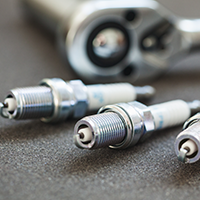
- a 24k gold base so that the spark plug will last the lifetime of the vehicle
- a little glass window so that you can see the sparks
- made of colorful porcelain, sometimes jewel-toned, multi-colored and “pretty fancy”
- handles on them so that they could be cleaned and reused
- contain pictures, such as one of a lady dressed in red, white and blue in 1700s-style clothing
- feature fancy logos
- have “weird funky looking electrodes, floating balls or spinning fans. You know. Nutty stuff.”
Values range, Ed says, from about 50 cents apiece to about $2,000 (really? wow). Early cars, of course, did not even have spark plugs. Instead, the internal combustion engines from the 19th century relied upon complicated and erratic flame and igniter ignitions. According to Gas Engine Magazine, the first spark plug probably originated in France with a ruby mica insulator, a brass body and the markings of “A.E.C.” A mystery! Nobody seems to know what those letters represent but the birth of the spark plug clearly foretold the death of the igniter.
By the early 1900s, more than 5,000 different brands of spark plugs were finding their way into Henry Ford’s Model Ts, including “For-A-Ford, Janey Steimetz & Company Flashlight, For 4 One, just to name a few.”
Insulation materials ranged from mica to stone to various kinds of porcelains, the latter of which often failed because of the extreme engine temperatures and porcelain’s porous nature, which allowed them to easily become clogged — an even more frequent event then than today, as early gasoline contained more oils and more closely resembled modern kerosene.
The year 1915 was pivotal. That’s when the Frenchtown Porcelain Company created a material that worked well as spark plug insulation material. In 1933, the discovery of silimanite extended the life of the plugs. From about 1900 until the mid-1930s, at least 6,700 spark plug manufacturers put their hand in the game, with more than 2,000 US patents filed on spark plugs, including “lots of gimmicks and gadgets.” Because so many brands once existed, Ed says that “it’s fun to try to find the huge, the weird looking and the very rare spark plugs. I’m fascinated by their design.”
When asked what kind of people are attracted to this type of collecting, he answers, “People who like mechanical things, old cars, old tractors, old hit and miss engines. The gearheads.” Ed has so many spark plugs that he maintains a small museum full of memorabilia behind the house.
“I’m sucked in,” he admits. “It’s addictive.”
A Gag-Worthy Collection
Steve Silberberg collects barf bags. Yes, those little bags that, when you can’t get to the bathroom in time, you vomit into. He owns some that were manufactured for use on airplanes, others for use in cars.
While you might think that Steve is the only one with this idea, he claims that there are “about 100 people who collect these bags somewhat seriously,” with “somewhat seriously” defined as having 50 or more bags. “Sure there could be people who have a couple of these bags come their way,” he adds, “but once you get to 50 or more, you have a collection.” (Steve, by the way, has approximately 2,500!)
Like baseball cards and other more socially acceptable collections, Steve trades bags with other collectors around the world. “About one third of the collectors — remember that there about 100 of us — live in Germany, with some living in the United States and others in Great Britain.” When asked why sickness bags seem to be a more appealing type of collectible to Germans (as compared to other nationalities), Steve has a good explanation. “My opinion is that because a six-week vacation is standard in Germany, they travel a lot. So, to show how great their travels are, some Germans collect these bags.”
Steve has met two other barf bag collectors in person while he lived in Dallas, getting together with them to examine one another’s collections in a restaurant. “We got some interesting looks from the people around us,” he recalls. “I guess a restaurant isn’t a good place to share these types of bags.”
Otherwise, these collectors communicate via the Internet. “I’d love to say we party,” Steve says, “but we’re not the partying type. I was an early adopter of the Internet, and I created a website for my collection so other collectors would find me. Now, anyone who has a sizable collection creates a web page, and we find each other.”
Steve includes photos of his bags on his website; on this page, the top two bags are from Avis Car Rental:
- The top one is from approximately 1993 and contains their slogan, “We Try Harder”
- The next one has apparently only been available at the Nassau or Freeport Bahamas airport. Advertising messages include:
- Call for a sparkling new Plymouth
- Free unlimited mileage (Steve points out that, although that sounds fantastic, all 700 Bahama Islands put together equal the approximate size of Connecticut)
We at Advance Auto Parts still had two more questions for Steve. First, how do people react when they discover what he collects? And, which barf bag is his favorite? “I get two different types of reactions,” Steve explains, “and I find them to be a litmus test about whether or not we’ll get along. Some people will be fascinated, perhaps not quite believing me, but finding it pretty cool. Other people have a look on their faces that clearly says 'why do you do that?’ and I know that I won’t get along with them quite as well.”
As far as favorites, he lists three:
- Finn Aviation air sickness bag from Finland
- “Most of these bags come with written instructions, but this one only has a cubism reindeer that is spewing chunks. It’s pretty cool, a real art piece and, with this bag, there are no language barriers.”
- MINI Cooper car sickness bag
- “This is an advertising piece. Cars don’t automatically come with one.”
- Space shuttle bag
- “This is the highlight of my collection.”
If you wish to donate a bag to the museum, you will become a Patron of Puke. That's something to keep in mind on your next flight.
What about you? What intriguing car-related items do you collect? What other unique collections have you seen? Share in the comments below.
